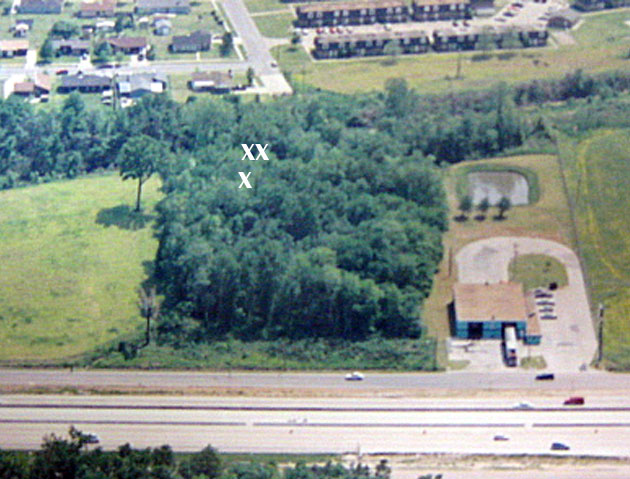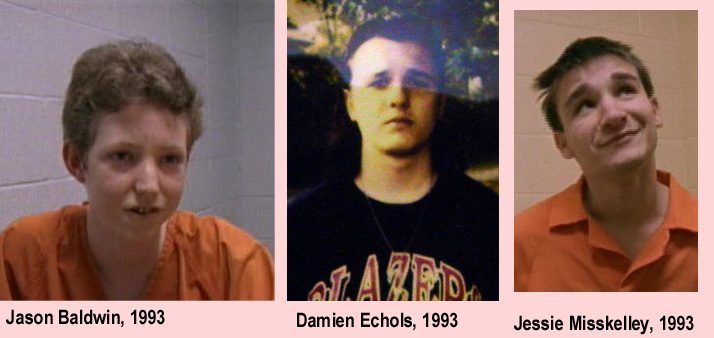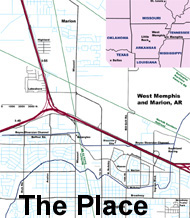Jivepuppi.com


Looking south.
Discovery woods (center) bordered by the interstate (bottom),
The Blue Beacon
Truck Wash (right), a bayou diversion channel (upper line
of trees) and a
meadow (left). Approximate site of discovery is marked by Xs.
A Twilight Kill, Part Two: True Believers
It was not until the next day, May 6th, that
the authorities joined the hunt in earnest, with Search and Rescue
teams scouring the nearby woods and a helicopter patrolling the area.
Shortly after 1 p.m., Steve Jones discovered a cub scout cap
floating in a ditch. And from the instant it began, the
investigation went horribly wrong. His discovery took place in a small
rectangle of woods, only sixty yards wide, bordered on one side by the
interstate and on another by The Blue Beacon, an all-night truck wash
for semis. Because these woods were just a quarter mile from where the
children were last seen this area had been saturated by searchers.
"Most of the people searching that day missed the clothing because one
had to stand right at the edge of the bank and look straight down,
Jones said." [Blood of Innocents, p. 416]
The police were called in and each step of the
discovery of the victims was documented in photos. First, Michael Moore
was retrieved from the ditch, his head bashed in. Then Stevie Branch
was discovered nine yards away, his face gouged. Finally, Christopher
Byers was recovered next to Stevie, his genitals mutilated. Each were
naked and bound wrist to ankle by shoelaces. Their shoes were found
nearby, all but one laceless. Other items of clothing were never
recovered, including two pairs of underwear and five of six socks.
There was no visible blood at the scene, suggesting the children were
murdered elsewhere. The initial Arkansas Crime Information Center
report declared, "their bodys (sic) had been dropped in a remote
place."
Jones stayed on until the bodies were recovered from
the ditch, then got sick to his stomach and fled. He was no mere random
searcher, he was the county juvenile probation officer in charge of a
teenager who would be convicted of the murders. Jones was also a true
believer. He spoke to an officer there at the discovery, James Sudbury.
"In our conversation I found that Steve [Jones] and I shared the same
opinion that the murders appeared to have overtones of a cult
sacrifice. During our conversation Steve mentioned that of all the
people known by him to be involved in cult type activities one person
stood out in his mind, that in his opinion, was capable of being
involved in this type of crime. That person was Damien Echols."
[Sudbury notes, Echols interview, May 7, 1993] Sudbury and Jones would
visit Echols at his trailer the
day after the bodies were discovered. Sudbury went on to compose a
32-item questionnaire for this case. The queries reflected his belief
in the cult nature of the crime including: "Do you have
or own a Bible?" "Do you believe in God - devil?" "Do you believe in
white or black magic?" And from this beginning the case became a
literal witch hunt eventually ensnaring three teenagers, charges of
Steve Jones and his supervisor, Jerry Driver. The teens would be
accused of witchcraft, Satanism and ritual human sacrifice.
Jessie Misskelley was seventeen. Short and muscular,
often sporting a goofy grin, he dreamed of becoming a pro-wrestler.
With a history of IQ examinations ranging in the mid-70s, he had
dropped out of school.
Jason Baldwin was sixteen, studious, shy. Long
blond hair, frail and skinny as a rail, he often took care of his
younger brothers after school while his mother worked the evening
shift.
Neither Jason nor Jessie had an air of the occult to
them. Damien Echols did. Damien was eighteen, had jet black hair and
would sometimes sharpen his fingernails. Brash and brooding, he cut and
burned tattoos on his body. He often walked around in a long trench
coat. When asked to write a self-affirmation during a stay in a
psychiatric hospital he wrote, "I feel good about myself and the things
I like about myself are that my will can not be bent and the ability to
scare people." [Exhibit 500, Echols sentencing hearing p. 487]

Although Jones and Driver's suspicions coalesced
around Damien Echols, their crusade against cults was ongoing. For the
past year they patrolled the rural areas together on nights of the full
moon, intent on preventing human sacrifice. Speaking about the local
cult activities, Driver would relate, "They were further uh, along in
their activities. . . they had reached the end of their animal
sacrifice uh portion uh to received power and that the next logical
step would be the sacrifice of a human." [Jerry Driver police
interview, December 3, 1993]
Although Echols had been convicted of only minor
non-violent offenses, Driver was convinced Echols was steeped in
devil-worship and intent on human sacrifice. "[Damien] and
[ex-girlfriend] Dianna was trying to conceive a child and that child
was to be sacrificed." [Driver, ibid] To support this charge, he cited
his interpretation of a cryptic doodle and intelligence from
"confidential informant people."
Driver repeatedly exaggerated Echols' record. In
1992, after the police caught Echols running away with his girlfriend,
Echols got into a screaming match with her father. While Echols
admitted to murderous thoughts, Driver described it as threatening to
kill the father and the policeman. [Exhibit 500, Echols sentencing
hearing, p.366] Even though no such charges were brought, it was
entered into Echols' records as "Damien was on probation due to
threatening his girlfriend's parents." [ibid, p. 368] This later became
"When the police picked up both Damien and the girlfriend, Damien made
threats to kill the police officers, the girlfriend of the father
(sic), and had confessed to devil-worshipping behaviors and
activities." [ibid, p. 368] In contrast, Damien repeatedly stated he
followed the Wiccan faith, a pacifist nature-based religion and Driver
stated Echols had always denied devil-worship.
Echols was consigned to a mental institution twice
for brief stays each time for confessing to be suicidal. During a
stay in juvenile detention an incident report was made, "One of the
boys scraped his arm a
little, it was bleeding some. Without warning, Damien grabbed the arm
that was bleeding, and began to suck the blood from it. [ibid, page
464]" This contrasted greatly with Driver's version. "Call from Jerry
Driver... Presenting problems [for Echols]: psychosis
homicidal...Notes: Knocked him [inmate in detention] down to the
ground, sucked the blood from the arm, rubbed it over his face and
body, and say [sic] he is a blood sucking vampire... also grabbed
another
person and tried to suck their blood. (p. 341)." In other iterations it
became sucking blood from the neck and claiming he worshipped the devil.
Driver hounded Echols during his
institutionalization. "6/10[92] Referral communication - spoke
with Jerry Driver concerning Damien. Mr. Driver was very focused on the
the pt. alleaged (sic) satanic involvement." [ibid, p. 298] The staff,
in turn, viewed their charge through diabolic lenses. ". . .draws
Satanic drawing and writes bizarre poetry" [ibid, pp. 428-9] The
drawings and
poetry, entered into evidence, were mostly reproductions of rock album
covers and lyrics.
While some would suggest Damien, born Michael Wayne
Hutcheson, adopted his new name from the antichrist character in the
Omen movies, Driver acknowledged he had met with the Echols' priest.
Echols had chosen his name after the Catholic saint, Father Damien, who
treated lepers.
Another target of Driver's claims was Dian Teer, the
mother of Echols' girlfriend. "[Teer] denied rumors she and her
daughter were involved in satanic worship and said rumors surrounding
the case are making her and her daughter miserable. ... 'Devil
worshippers are not supposed to say the name 'Jesus,'' Teer noted.
Teer, after a short pause, she said 'Jesus, Jesus, Jesus,' to prove
that she is not a devil worshipper. ... [Teer] wants to show
people that when she walks into church, she 'won't burst into flames.'
[June 8, West Memphis, Evening Times] She went on to say, "the only
kind of group that I was ever in like that was the Rocky Horror Picture
Show." [Dian Teer, investigation interview, September 10, 1993]
In the coming years Driver would be
found guilty of embezzlement and Sudbury would be dismissed for
multiple infractions.
Continued in, A Twilight Kill,
Part Three: Detective Bryn Ridge











